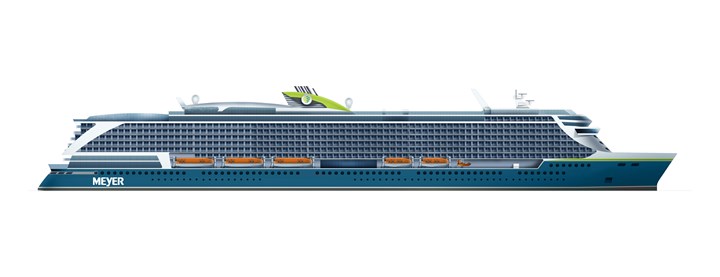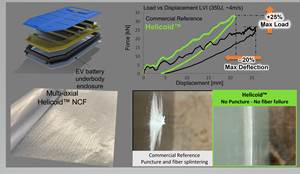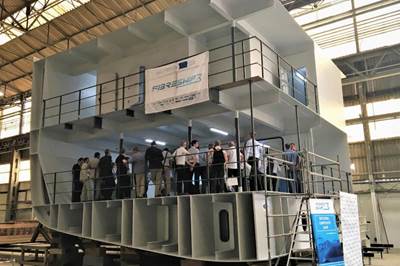GreenLight project explores fire-resistant and bio-based FRPs for structural lightweight design in ships
Project leader Fraunhofer IFAM and six associated partners to study FRPs such as polybenzoxazine- and benzoxazine-based composite materials to meet strict safety regulations, requirements on passenger ships.

Starting materials for the development of fire-resistant and bio-based fiber composites for structural lightweight design in ships. All photo credit: Fraunhofer IFAM.
The GreenLight project, under the leadership of Fraunhofer IFAM (Bremen, Germany) and with project partners Meye Werft GmbH & Co. KG (Niedersachsen) and INVENT GmbH (Braunschweig), aims to develop bio-based composites with intrinsic fire safety for use in load-bearing structures in shipbuilding. The project will also cover manufacturing and recycling concepts. Meye Werft and INVENT are to contribute expertise in materials development, manufacturing processes and shipbuilding. Associated partners, including Huntsman Advanced Materials (The Woodlands, Texas, U.S.), SAERTEX GmbH & Co. KG (Saerbeck, Germany), Lloyd’s Register (London, U.K.) and nova-Institut (Hürth, Germany) will provide support and experience in materials, semi-finished products, sustainability, approval and operational safety.
According to Fraunhofer IFAM, the Greenlight project was born out of the increasing use and potential of fiber-reinforced polymers (FRP) in rail vehicle and boat construction. While glass fiber-reinforced polymers (GFRPs) are cost-effective, corrosion resistant and can be used to manufacture complex, multi-curved components, steel and, to a lesser extent, aluminum, still dominate passenger ship construction because the necessary approval for use in “SOLAS” ships — any ship to which the International Convention for the Safety of Life at Sea 1974 applies — has not yet been granted for load-bearing FRPs. This is especially true as passenger ships are subject to stricter safety regulations, which are specified by the United Nation International Maritime Organization (IMO) through global standards for the safety and operation of, for example, cruise ships.
The “Interim Guidelines for use of fiber reinforced plastic (FRP) elements within ship structures: fire safety issues,” however, lay down the basic requirements for the use of FRP in SOLAS ships. According to these guidelines, integrated structures or nonstructural parts that do not contribute to the strength of the ship can currently be replaced by FRP.
According to Fraunhofer, FRP components’ temperature resistance and fire behavior are highly dependent on the organic polymer matrix. When heat is applied, thermal decomposition of the polymer occurs by pyrolysis processes, in which the decomposition temperature, the gases produced, their flammability and toxicity are significantly influenced by the chemical structure of the polymers used. In order to obtain approval for such a material for SOLAS ships, high fire protection requirements in particular must be met.
Per the GreenLight project, polybenzoxazine-based composite materials are said to show promising properties with regard to preventive fire protection and are characterized by lower heat release rates, lower smoke gas density and toxicity in the event of fire. Project partners believe that, even without the use of halogenated flame retardants, these materials have high potential to meet fire safety requirements in various applications, including marine.
Partners are also focusing on accessible bio-based polymers and benzoxazines for FRP materials that are characterized by a lower CO2 footprint over the entire product life cycle compared to conventional, petroleum-based materials. Phenolic components, amines and formaldehydes are required for benzoxazine synthesis, and these components can be obtained from conventional petroleum products, but also from renewable raw materials such as corncobs or sesame seeds. Under this project, research will be conducted into sustainable benzoxazine-based composites in terms of sustainable chemistry. In this context, special attention will be paid to environmental and social factors in the selection of raw materials (origin, extraction, etc.) as part of a sustainability analysis.

Fire-resistant and bio-based fiber composites have great potential, especially for structural lightweight design in cruise ships. Photo Credit: Meyer Werft
To further reduce the CO2 footprint, project partners expect to also equip the FRP materials with sensors to monitor the material’s conditions during operation, ultimately to improve upon the design of materials in production and reduce the number of maintenance cycles and maintenance effort.
Sensors can be integrated by inserting film-based or printed sensors in the form of pastes. These approaches will be applied to bio-based polybenzoxazines with basalt fiber reinforcement. In addition, concepts will be developed by which data from the sensors can be used for structural health monitoring (SHM). These data also form the basis for a digital twin that maps the material over its entire life cycle (design, creation, operation and recycling) and can be used to evaluate long-term properties.
In particular, the high-performance plastics, such as the benzoxazine-based materials to be researched here, are said to have a high value-added potential, as material upgrades can be reached when they are recycled in alternative applications. Recycling existing materials or even components reduces the use of raw materials. However, this presupposes that the components can be dismantled into materially pure components for further material use. Against this background, the topic of recycling-friendly design concepts for dismantling material composites at the end of life or for a necessary repair during the service life is of importance.
This project is funded by the Federal Ministry for Economic Affairs and Energy BMWi.
Related Content
University of Maine unveils 100% bio-based 3D-printed home
BioHome3D, made of wood fibers and bioresins and entirely 3D printed, highlights Maine’s effort to address the need for more affordable housing.
Read MoreNatural fiber composites: Growing to fit sustainability needs
Led by global and industry-wide sustainability goals, commercial interest in flax and hemp fiber-reinforced composites grows into higher-performance, higher-volume applications.
Read MoreJEC World 2024 highlights: Glass fiber recycling, biocomposites and more
CW technical editor Hannah Mason discusses trends seen at this year’s JEC World trade show, including sustainability-focused technologies and commitments, the Paris Olympics amongst other topics.
Read MoreHelicoid Industries releases three use cases of Helicoid technology
Use case applications with Helicoid technology implementation demonstrated mechanical performance improvements, such as impact resistance and strength.
Read MoreRead Next
Removing barriers to lightweighting ships with composites
EU consortia propel large demonstrators, new technology and affordable certification.
Read MoreComposites end markets: Energy (2024)
Composites are used widely in oil/gas, wind and other renewable energy applications. Despite market challenges, growth potential and innovation for composites continue.
Read MoreCW’s 2024 Top Shops survey offers new approach to benchmarking
Respondents that complete the survey by April 30, 2024, have the chance to be recognized as an honoree.
Read More

























